
Josie Lim Cruz (second from left) at the MoMA, New York City
Josie Lim Cruz’s Vital Gestures
by: Christiane de la Paz
February 2012–Well-regarded by critics, artists, collectors and art students, Josie Lim Cruz began her artistic career in Manila during the mid-1980s but emigrated to America in 1995, where she continues to paint, teach, conduct workshops and curate exhibitions. Her achievement has never received full recognition as a painter in command of her personal style of harmonic abstractions. Her paintings are best appreciated for their subtlety, their directness and her own aesthetic. In this interview, Josie Lim Cruz tracks her growth as a painter from her earlier works to her mature style of painting and makes known how she embraces gesture, experience and emotion with direct and raw energy, for the readers to locate her in the continuum of her times.
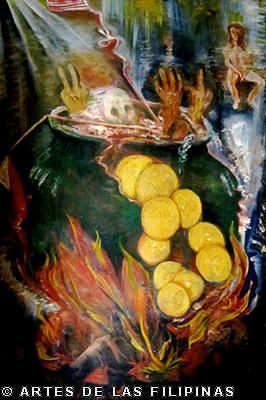
Simmering Pot (1987)
What batch are you from in the UP College of Fine Arts?
I was a 1991 graduate and unexpected cum laude. My first course was Health Education where I had mediocre grades so I did not know these were not factored in with my BFA ratings. Had I known earlier, I may have aspired for summa cum laude.
Chabetized 2 (1988)
What made you decide to study fine art?
It was sort of a gift from my husband who sent me to school. I was struggling with fine arts materials and methods so he suggested I enroll for workshops. Later, my workshop professor, Mr. Carlos Valino, advised me to register formally for the degree. It was also my passion from childhood but my parents preferred that I choose more stable and conventional career.
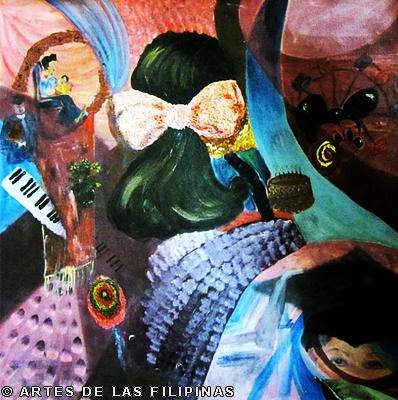
Profound Me (1988)
Who are your contemporaries in UP Fine Arts?
Jonathan Olazo, Nolet Soliven, Ruel Rilloraza, Trek Valdizmo, Mark Justiniani, Jo de Leon, Romeo Lee, Marcel Antonio, Yasmin Sison, Jun Veloira, among others. Manny Garibay was a year ahead and I saw him at his solo exhibit in Washington DC about two to three years ago.

Going and Coming (1989)
Who are your professors in UP Fine Arts?
Mainly, Bobby Chabet . Although he was known as a terror, he can really teach, and he can “opens doors” for his students by encouraging them to mount exhibitions. Unconventional, cutting wit, tantrum-prone, enigmatic-package- of- a- teacher, but he is worth all the sweat he exacts from students.
Also, Gig De Pio who was right when he mentioned that not every artist can do portraits. Said he had lots to give, when I asked if he was not afraid he was revealing too many secret pointers in portrait painting.– it’s a gift, so said Prof Valino. Sandra Torrijos for her quiet efficient projects. Ginny Dandan for her strict sculpture strength as exemplified from her tall-as-houses-paper mache sculptures she made for the Lantern Parade. Benjie Cabangis for solvent techniques. Professor Valino for color mixing and painting from memory techniques and Dean Jose Joya for post-graduate advising and art marketing
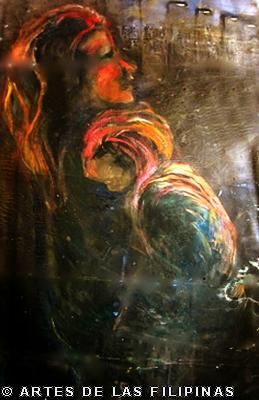
Madonna of the Streets (1989)
After graduating, what was the first job you applied for?
After finishing my degree in nutrition, I went to the US for my internship and post-graduate studies in Nutrition and Dietetics and worked at a few hospitals there for two years then I came home and became the assistant manager of the Philamlife Cafeteria in UN Avenue for five years. I also taught nutrition at St. Luke’s Hospital College of Nursing in Quezon City. My husband asked me to quit and stay home with the kids, but as always, I kept painting amateurishly. Then in 1991, after graduating BFA, I was self-employed. I accepted portrait and painting commissions, launched exhibits, sold my paintings and taught small workshops.
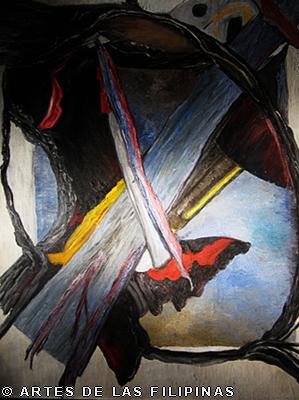
Heartbeat (1990)
After this stint, did you have another job?
We emigrated to the US in 1995. From 1996-2000, the Jewish Community Center of Greater Washington hired me to teach art to children and adults. Other jobs I had include teaching art privately and giving piano performances at various retirement and nursing homes. I was also curator of my students’ solo shows and other group exhibits. Then I did some art writing tutorials, copyrighted and electronically marketed on the Internet and CDs.
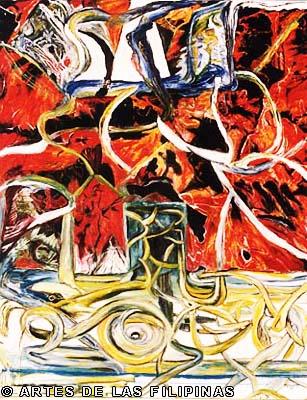
Fling (1991)
Did you take formal lessons in curatorship in America?
My stint as a member of the Cultural Commission of Rockville where we judged and chose all major artworks and activities to be commissioned to various artists for the city sites; activities at the Rockville Art Place and schools, attending lectures and seminars in Washington DC area museums; on-line classes on the subject and readings. But mainly, I think experience and hands-on curating plus innate ability in discerning art presentations are invaluable in making an exhibit successful. Being an artist who also exhibits is a big factor. And then I also have observed how Bobby Chabet expertly curated our exhibitions.
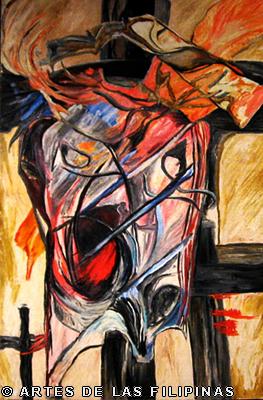
Penitential (1991)
You first entered the art scene in 1988. What is the status of the art scene during those times? Was the landscape of the art scene paving ways for young artists?
The Philippines had a lively art scene, spiced by numerous controversies that only artists can create. Art was used for environment protection protests and there was friendly and not-so-friendly competition among some artists. My husband being connected to the FFCRUZ & Co. Inc. that was in the business of vertical and horizontal infrastructure was once a target of art colleagues who had either pro or con leanings on the Manila Bay reclamation. But these were not serious happenings. I survived without a scratch. We had lots of group shows, both with the Chabet group and our Joya group. Many multi-national and local companies sponsored contests that propelled the company’s image in the cultural sense. There was Shell, Metrobank, Yellow Pages Cover of PLDT, etc.. There were also many galleries that helped artists and made commissions from their sales of paintings. Money was not tight then so there was room for art collecting. Many noted collectors banked on emerging artists for better prices and speculated on their being “collectibles’ at some time in the future.

The Moonshine (1991)
Tell me about your first exhibit.
My first exhibit was at the Institute of Tourism in 1987. It was a group show with my classmates. I was attracted then to themes depicting social-realism. My oil painting was “Paano Uuwi si Ana” that showed Ana flagging a moving jeepney full of “sabit” passengers seen from a rear jeepney view. That painting is with Dr, Ibe, former regent of UP in the 1990s. Then I did another one #2 with the same theme, that won an Award of Excellence from Shell, exhibited at the Quad and purchased by Architect Dong Arguelles whom I still have to meet. The same scene #3, I repeated here in the US and now owned by a collector. Since the Institute of Tourism show was a minor exhibit, there was not much fanfare.
A little later, a group of us six student artists were chosen by Chabet to exhibit at the UP Arts and Science Building. This is notable, because Mrs. Nieves Epistola discovered me there. Her class in art history was asked to choose the painting they preferred. Among the six, two were chosen. When I showed up to talk about my work, they were surprised that it was a mother who did this big abstracted piece. From then on, she became one of my collectors and promoter. One of my paintings she donated now hangs at the UP Main Library Filipiniana section along with notables like Vicente Manansala, Anita Magsaysay-Ho, etc.

The Red Thing (1991)
What was the first gallery that carried your works?
The West Gallery in Timog Avenue. It was where I held my first solo exhibit. It was a success, brilliantly curated by Professor Bobby Chabet. Many guests and artists attended, too. The exhibit titled was “Mom Josie,” a monicker given by my classmates who were my children’s age. Rico Manlapaz purchased two paintings and several more were also sold to some guests. Majority of the abstract expressionist paintings were huge, measuring five feet by four feet.

Blue Marlin (1992)
For the ideas of your own exhibitions, how do you try to be different in concepts and executions?
My early exhibitions sprung from collage studies. This was the method taught by Chabet. To this day, I employ much of his method but my own concepts filtered in. I don’t really try to be different since I feel that concepts and style come naturally and should if one wants to enjoy painting. I don’t remember who said: “So-and-so paints so well. Maybe we ought to cut his hands so he can think.”
Usually, a concept comes to mind like when I did Golfspeak # 1. My husband used to play golf two to three times a week so I thought of making fun of the game was a good way of golf widows getting even as well as a fun exhibit to do. He furnished the usual golf terms that I executed on canvas.
For my other abstract compositions, my take off spring from unusual colors, lines forms or shapes, or a combination of all that I put together to form a composition. Usually, a recognizable object finds its way in the painting. When Barack Obama was elected, I had this idea to paint his portrait in various colors but someone beat me to it. Although mine was late in the coming, I still did it, my own way. I also did a large 9-11 painting immediately after the bombing of the Twin Towers which showed different ethnicities. I titled this “One Country, One People.” This particular painting of mine has been exhibited many times here.

Black Gold (1992)
When you are in the process of working, who exactly is the viewer you have in mind?
The viewers are the target audience such as my Filipiniana series which goes well with homesick Filipinos abroad; Santa Cruzan in DC, Filipina in Venice are hot topics for me. My last work on the subject had three guest inquiries. The first one got it. Something at Somewhere is my current favorite theme on the same shaped canvas. Most of the times, I really don’t consider the viewer but my own mood at the time and with the times.

Do you agree that the first exhibit of a painter could make or break his career? Did this apply to you?
I think promotion of the artist is the more effective way. A good example of that is Andy Warhol’s career. Like children of well-known artists have a great advantage. Having an unselfish mentor like Bobby Chabet opens many doors to artists he thinks are worthy of his care. Of course, not all the promotion in the world will help if talent is absent. Artistic talent is in the genes. My husband cannot tell green from blue, red from orange. But he is a whiz in math while I can’t do multiplication without a calculator till now. Here, in the US they will not keep me teaching, nor would students keep on coming only because they love me! Maybe there is something I can impart to them because many who came my way have learned and gone on to the mainstream.

Pinatubo (1992)
Are you a member of any artist’s group?
I was with Joya’s VACOOP Intramuros Group — a group of fifteen artists who met weekly to paint portraits of noted sitters. I was also a former member of the Art Association of the Philippines. In America, I was a former member of VISARTS, Brown Strokes, PALM which is a writer and artist’s group. I am also a former board member of the Cultural Arts Commission of Rockville, MD, and Rockville Arts League.

Black Rose (alkitran) (1994)
What do you think are the advantage of being part of an artist’s group?
Camaraderie, contacts.

Party Collage (1993)
And the disadvantages?
The risk of being copied if one is that insecure.

Hybrid (1993)
Have you ever won any important awards?
Award of Excellence, Shell Competition 1989; Finalist, Art Association of the Philippines 1995; Juror’s Choice, Rockville Arts Place, Rockville MD USA, 1998; Juror’s Choice Rockville Arts Place, 1999; Mayor’s Person of Character Award, for a painting depicting the pillars of character building, mid-2003

Lily (1993)
Do you think a painter can become commercially successful without receiving any awards?
Yes. Many are even self-taught. Although I believe even innate talent can be helped and professionalized by schooling, promotion enhances exposure that makes an artist marketable. Andy Warhol is a very good example of an artist who really did a lot of unabashed self-promotion.

Moon Beams (1993)
Whose style are you drawn to painting during your student years?
Danny Dalena for his subject and rendering. Georgia O’Keefe’s paintings as photographs. When I saw her works on canvas, I was looking for textures and couldn’t find much. Paul Jenkins too for his colors and shapes.

Puring’s Choice (1993)
What about foreign influences?
Van Gogh’s textures, Alexander Calder’s wire sculpture portraits and mobiles, Peggy Guggenheim’s gate of her museum in Venice. Georgia O’Keefe’s paintings as photographed, not her paintings on canvas.

Swirly Whirl (1993)
Who handles the business side of your profession?
It used to be West Gallery in the Philippines. Here in the US, my art business is under the umbrella of LIMCRUZ.

Thinking of Georgia
Do you have an idea of the profile of collectors who have collected your works?
Nieves Epistola, AA Cruz, Mr. & Mrs Nick Villaseñor and gallery owner, Rico Manlapaz. They always buy from all my solo exhibits. Many are whimsical, commissions, a number I don’t even know.

Rosebud (1994)
What has been the best compliment said about you or your work?
When people I don’t know or haven’t met purchased my works. Collectors who follow my exhibits and get one or more for their collections are a treasure. Then, being scooped by an art writer who was attracted by the exhibit is also a welcome surprise. Another would be I’d be asked by a fellow artist to swap works. Snippets of comments that are amusing and thought – provoking can also be considered compliments such as: “frenzied brush strokes,” “subjects may be different, but still recognizably you;” “masculine strokes but feminine colors” An interesting ambivalence although a sexist comment. Then there is the, “How in the world did you paint huge canvases, did you climb up a ladder?”

Filipina Sino Siya? (1994)
And what have you been criticized of?
My own children did not like my abstract paintings until people started to buy them. My husband wants me to do impressionist recognizable paintings like Fernando Amorsolo.

Balikbayan (2004)
Tell me about your early life.
I studied music from Solfejo singing notes with piano. Eventually, I took piano lessons from a master up to being able to play Chopin, Liszt, Mozart, etc. I am a voracious reader, too. I loved to write almost about anything. I am a dietitian and is a member of the American Dietetic Association. I practiced dietetics for two years in the US, five years in the Philippines as cafeteria assistant manager at Philamlife then I got married at the same time.
I also taught part-time for two years at St Luke’s College of Nursing. I enrolled for art workshop after flunking the entrance test for a fine arts degree in UP but Professor Valino recommended that I take a formal course as a fine arts student. In UP, I had a traumatic introduction to Chabet who required me to take the whole course when all I needed was to complete an incomplete requirement from Benjie Cabangis. Chabet asked me to paint different angles four times! The same subject junk where dirty crumpled newspaper was wrapped rusting chicken wire shaped like a head. We used this for sculpture clay molding. I got mostly a grade of 1.0 from him and I ended up a cum laude. Even stingy professors who gave me a grade of 2.0 such as Benjie Cabangis could have been more generous.

Paano Uuwi si Ana (2004)
Why did you and your family move to America in 1995? Have you always been based in Maryland?
We chose Maryland because my brother lived here. Many of our relatives are in California but we were terrified of earthquakes. My husband Rody had a long-standing petition from his sister that we almost forgot. We waited for the deadline to finalize our papers since we were undecided till the last minute. But because we were familiar with life here, we went for it all the way, mainly for adventure.

Praying Hands (2004)
What are the adjustments you had to make as a Filipino mother and artist?
The kids were all grown, except for the youngest who was still in college. The two eldest were sponsored by companies here. One even agreed to shoulder relocation costs to transfer from the Philippines so she and elder sister, Rhoda were here a few years ahead. The same type of mothering applied as they were all grown up and eventually got married within two to four years here. The youngest, a boy, continued his education here in the US.

Creation 2 (2005)
How did you re-establish your artistic career in America?
I joined art groups, art shows and other civic organizations here. I also decided to reply to advertisements for art teachers. The Jewish Community Center for Greater Washington (JCCGW) then hired me based on my credentials. I did regular workshops and I also conducted several special classes and special one-on-one with private art students and groups. For me, workshops are more appealing since adult students came to learn, unlike formal school where art is a required subject. I enjoyed teaching when students set out on their own. One or two of them sold their paintings better than I did mine, price-wise. Some of their paintings are on my blog.

Four Generations (2005)
Have you always signed Lim Cruz in your canvas?
I’ve always signed my paintings Josie Lim Cruz, although my maiden name was Josefina R. Lim; R is for de la Rosa. I am giving the locals a hard time with my surname. They hyphenate it –Lim-Cruz–make L a middle initial. I tell them, “Hey, I am not a hyphenated woman!” Some computers do not take Lim Cruz as a surname, so they are linked as one. Eventually, they seem to be getting used to it since I have seen some political local women leaders starting to retain their maiden names without hyphen. I took the opportunity to make my three-worded name official upon signing up for US citizenship but we are doing dual US-Philippine citizenship. Josie Lim is for the artistic credit. Cruz is for my status as wife to husband Rody, who incidentally, encouraged and sent me to art school after hibernating as a housewife for most years of our married life.

Hello Violet 2 (2005)
How do you get updated on the Manila art scene?
I read on-line news and newspapers. Catch up on artists who visit and exhibit here and in New York. Stories of art from my patrons and collectors.

Abstract Designs for Pendants
Let’s say you are still based in Manila, how do you think your career would have fared by now?
I probably would have taught less and exhibited more. So many students have been to my classes here for fourteen years and it has been a pleasure to see them grow and become colleagues. The icing on the cake is that each and everyone developed a style of their own. I try not to demonstrate or paint in class so that my students will not be mini-Josies but be their own artist-persons.

Play With Me (2010)
You have been around the art industry for quite some time, do you still get insecure at this point in your career?
No. I think I know that there is that special something from God. I’ve seen my artworks spark interest here countless times and eventually ended up purchased even in these recessionary times. Then there are a few times, a certain painting is inquired about and commissioned repeatedly which is why I have Golfspeak and other paintings numbered, Party cocktail drinks, Slices of Venice or Wherever, DC — scenes in unique elongated formats.
Gallery membership is a must. Aside from the MOCA in DC, I plan to join Foundry Gallery in the DC area for regularly scheduled exhibitions. Gallery memberships here assess prohibitive fees. I would have wanted to do more Philippine-based solos for the sake of my Philippine collectors and patrons, but Soler of West Gallery wanted originals that are difficult to transport. Unless a sponsor will shoulder the expenses for shipping and taxes on finished paintings, an artist has to stay for a few months on exhibit site to do paintings. Our Rockville galleries are also giving exhibit opportunities for art organizations. Portrait commissions are always there and so are my other “loves” including writing and music. At the moment, I am now working on sequels to my copyrighted tutorial DabPaint titled ArtVentures.

One Country, One People (2011)
What makes you insecure then?
Not exactly insecure but maybe partly I get “Jewish-conscious.” Many of my students are surprised that I teach at their school and I joke that I am almost Jewish too, having associated myself with them all this time. They are wonderful people and colleagues, more conservative than the average non-Jewish Americans. I am very comfortable around them and vice vera. They greet me “Merry Christmas”, I wish them “Happy Hanukkah.”
Serious Hybrid (2011)











